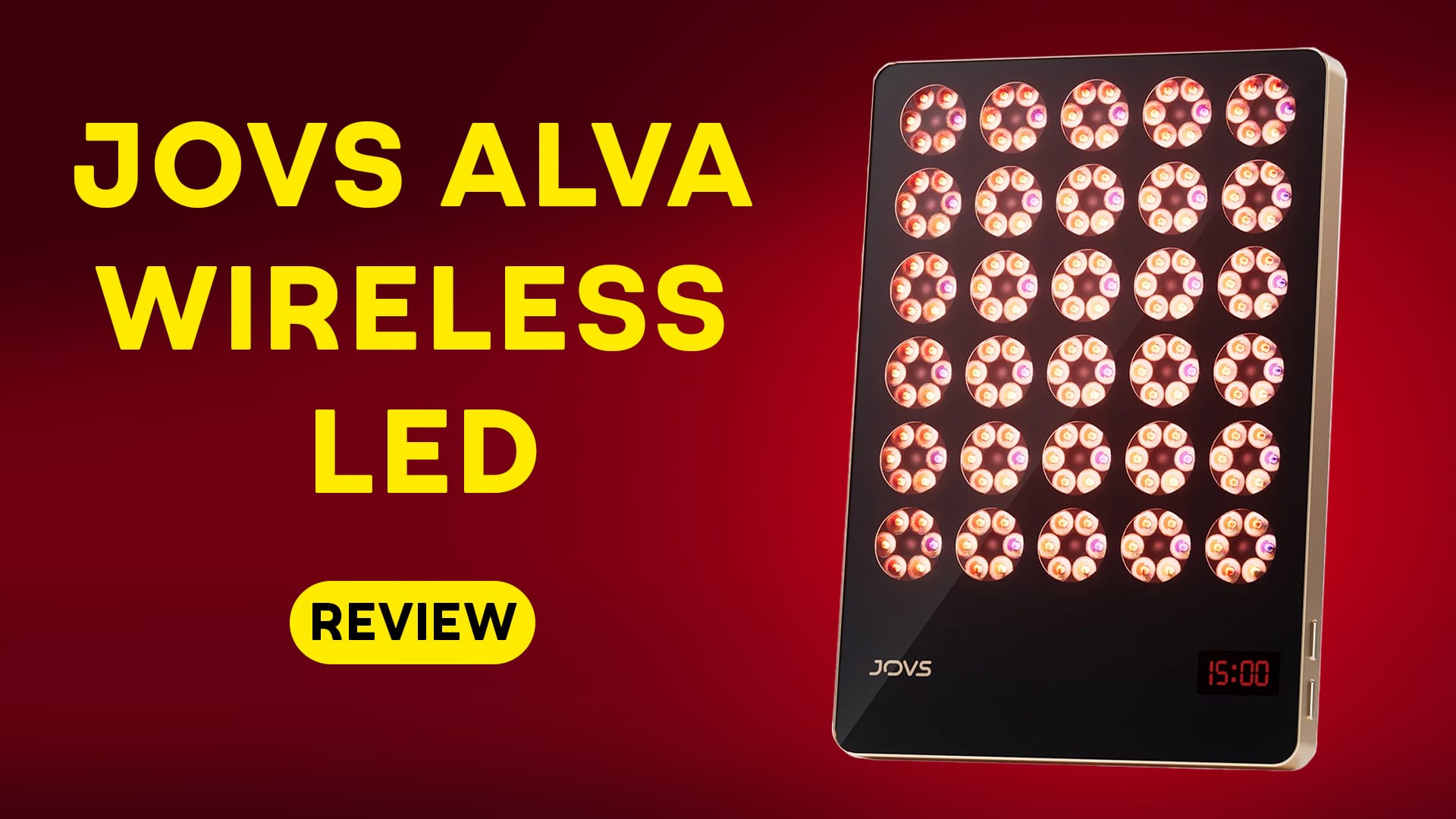Are you in the market for a portable, versatile light therapy device for skin rejuvenation? The Jovs Alva Wireless LED device might be what you're looking for. With its array of wavelengths and compact design, it's generating buzz in the light therapy community.
But does it live up to the hype? I've been putting it through its paces to see if it does and if it is worth your investment.
The Company Jovs 4D
Jovs sells its Alva Wireless Light Therapy device and offers skincare and beauty products. I reviewed their 4D-laser mask last year and was very impressed. You can save on that mask with code ALEX - and on the panel I'm reviewing - after you click the link!.
First, we can talk about what makes this device stand out. It's a portable, wireless LED panel that's supposed to offer many different light therapy benefits. The company claims it has six different wavelengths and 20 modes, which sounds impressive.
But here's the thing - we all know that marketing claims and reality sometimes don't match up.
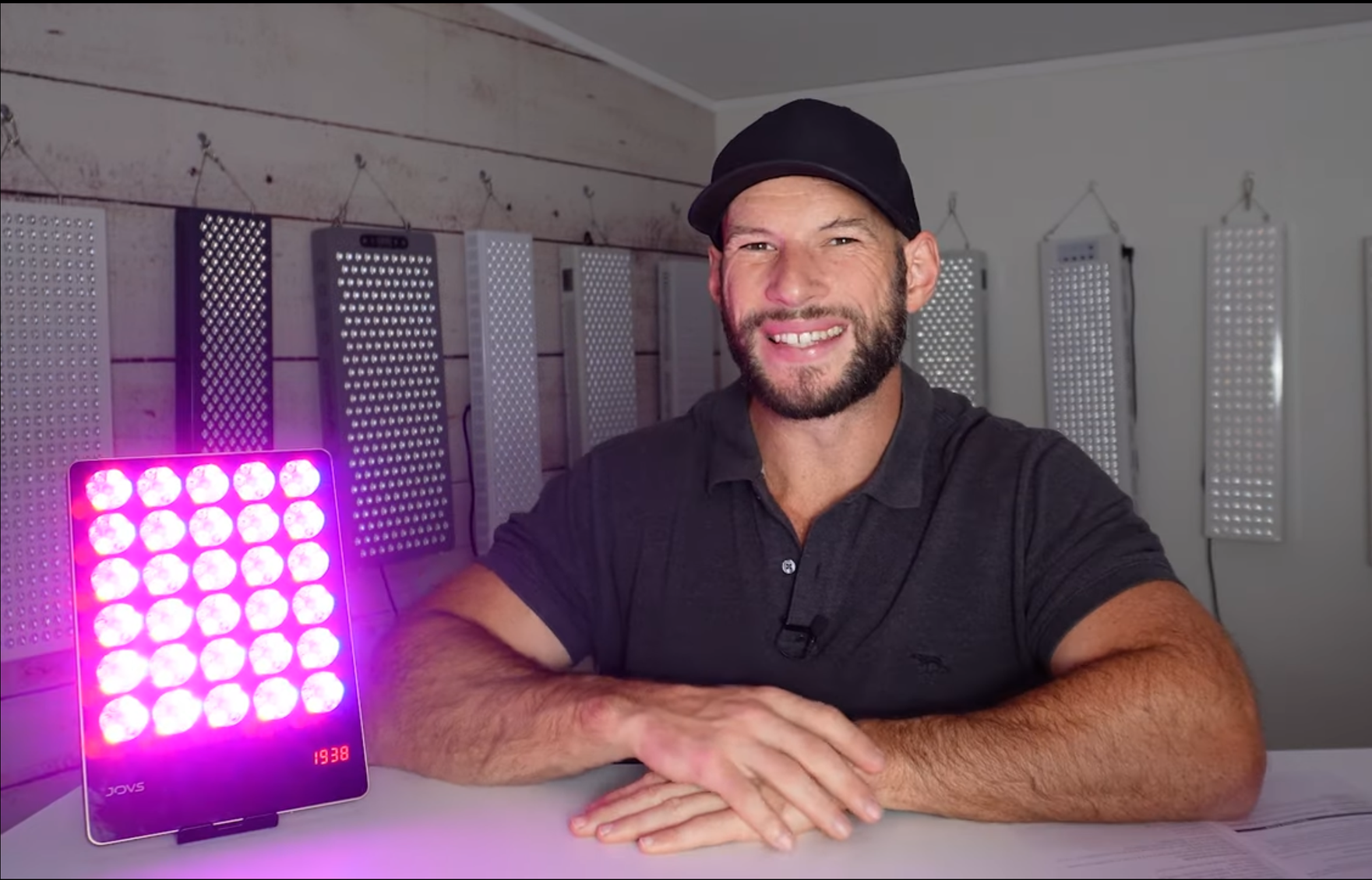
Size And Portability: A Traveler's Dream?
One of the first things you'll notice about the Jovs Alva is its size. This compact panel measures 10 inches by 7 inches and is less than an inch thick. It weighs about 810 grams, just over a pound and a half.
For frequent flyers, this could be a game-changer. It's small enough to toss in your carry-on without taking up much space. Plus, it charges via USB-C, so you don't need to lug around a special charger.
Modes
This panel has 20 different modes. I will not go through them all—you can see them on the website—but I’ll touch on a few.
There’s acne mode, soothing mode, skin rejuvenation mode, skin tightening mode, hydration mode, oil control mode, anti-aging mode, whitening mode, after-sun mode, hair mode, sleep mode, and spot-reducing mode. It's interesting how many modes there are and how many crossovers there are between them.
Looking at them all, I would run the whitening mode because that has all the wavelengths running.
Wavelengths
Now, let's delve into this device's main feature—the light wavelengths. Jovs claims its six colors/wavelengths benefit skin health, particularly the Alva.
• Blue (460nm) for hydration, balance, and acne treatment
• Yellow (590nm) for repair and calming
• Amber (610nm) for rejuvenation and brightening
• Red (630nm) for collagen stimulation
• Crimson (660nm) for circulation
• Near-infrared (940nm) for boosting metabolism.
Each is supposed to offer different benefits, from acne treatment to collagen stimulation. This sounds great in theory, but how does it hold up in practice?
Let's fire up the spectrometer:
First, because of the layout of these LEDs, it’s pretty tricky to get balanced readings, but I aim to capture all the wavelengths in one shot.
I first notice the abundance of blue light—it seems overpowered. But let’s focus on the peaks. We’re seeing a peak at 453nm, slightly off from the marketed 460nm.
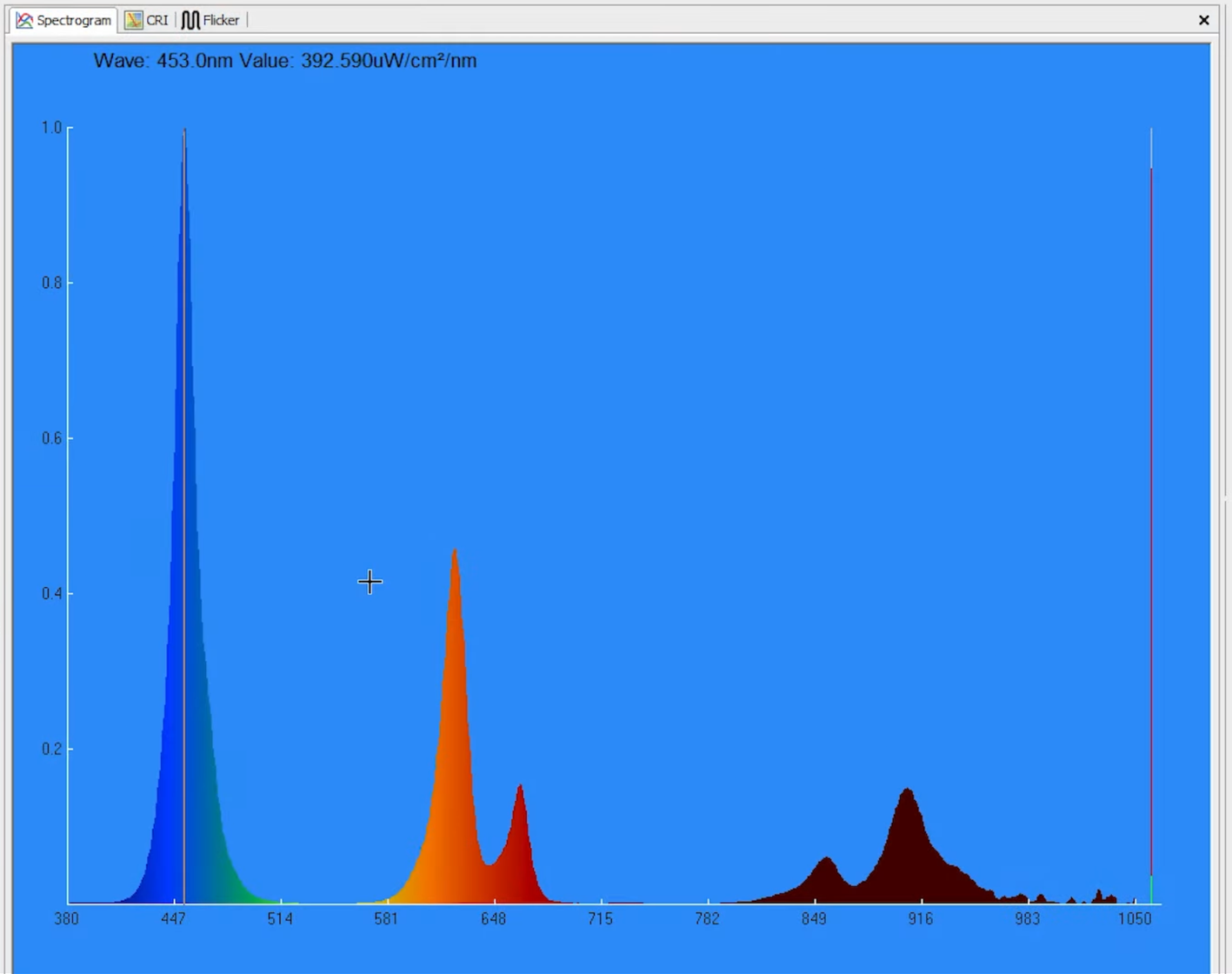
Moving on to yellow, which should be at 590nm, only a tiny 590nm is present. Let me zoom in for a closer look in yellow-amber mode.
Here, we see a peak around 600nm. The amber was supposed to peak at 610nm, but it seems more like 600nm. Some 630nm is present, and we have another peak at 660nm, which is great as that’s your crimson wavelength.
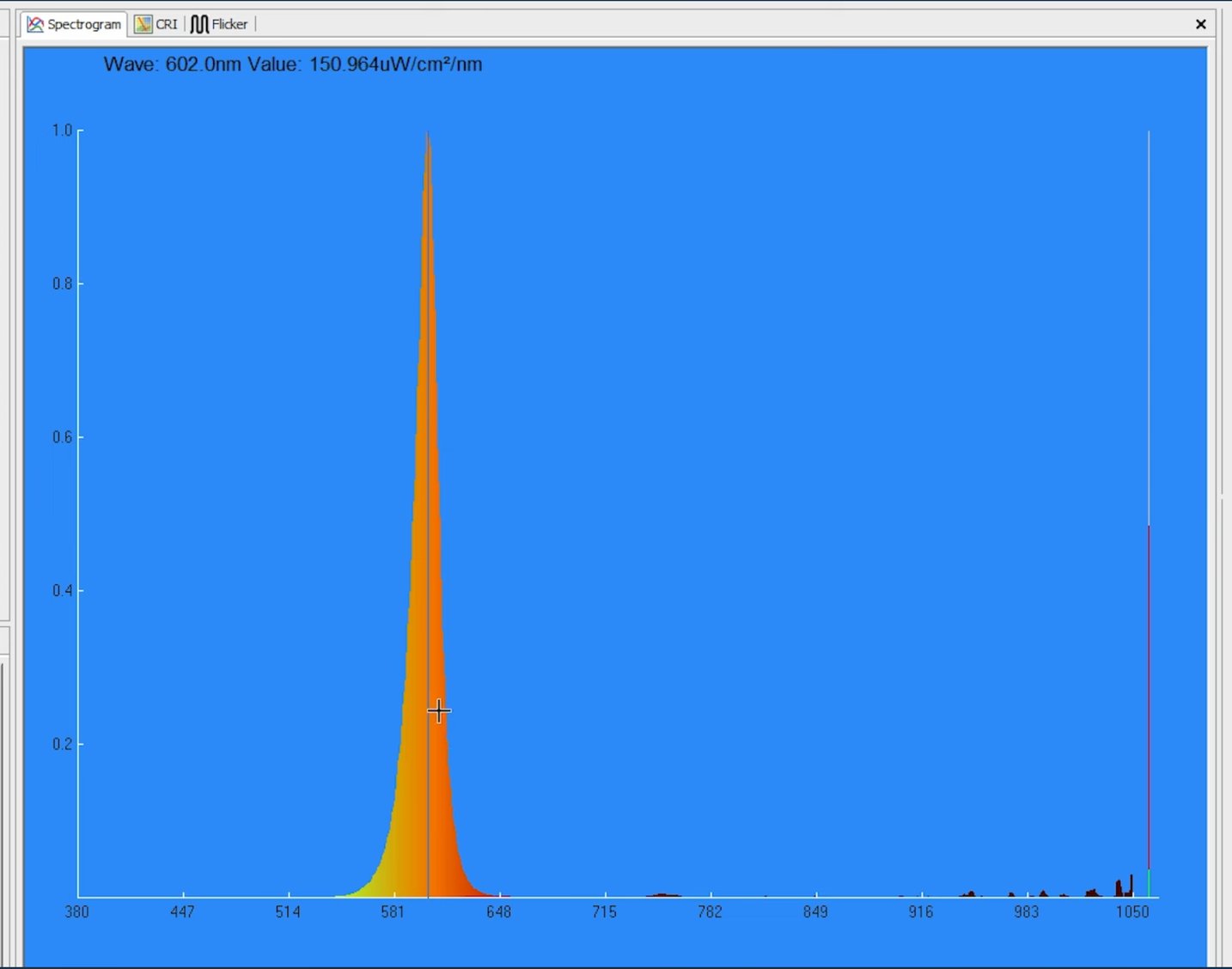
The near-infrared is supposed to be at 940nm, but there’s barely any 940nm here. Instead, we’re seeing peaks at 910nm and 850nm.
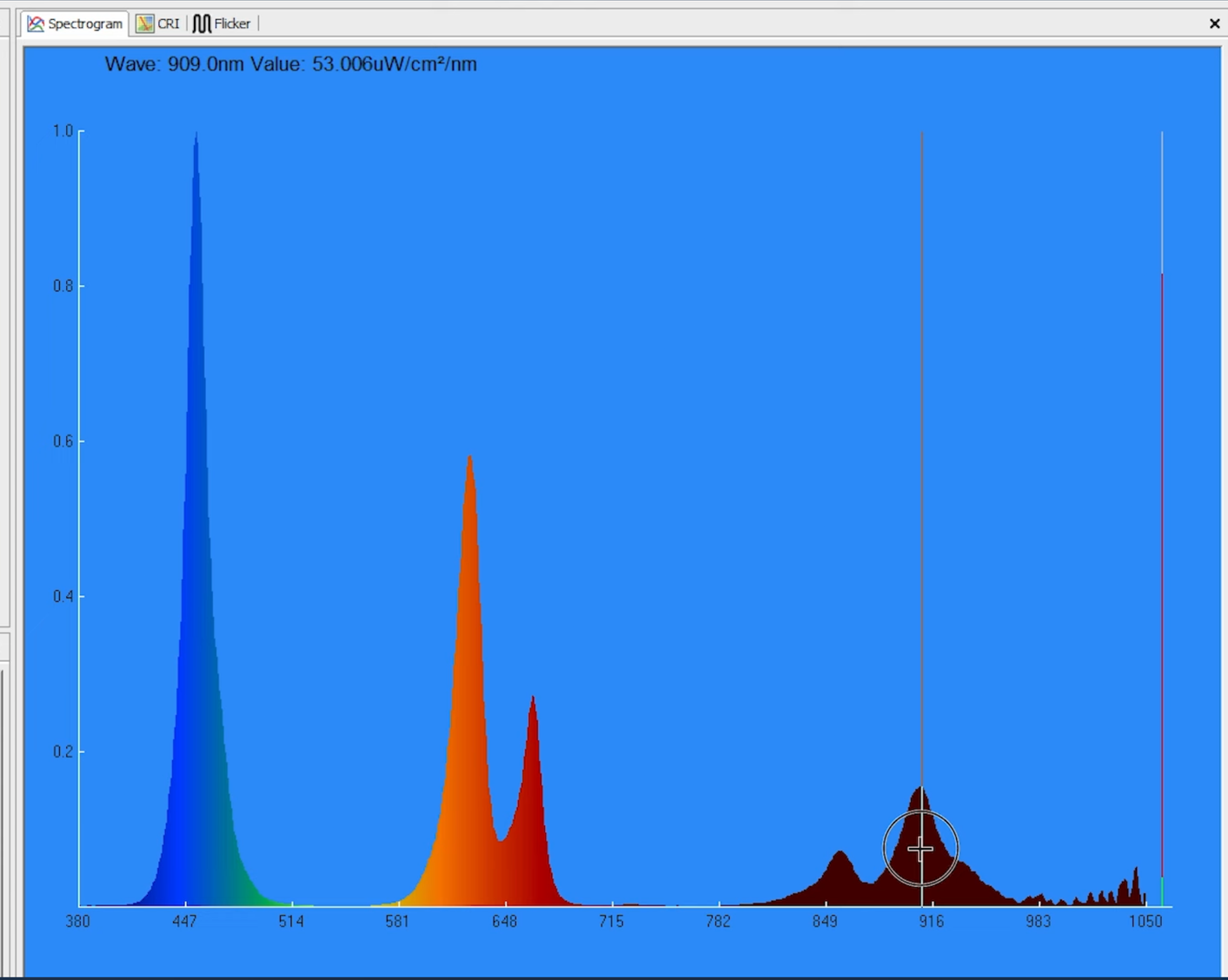
So, overall, it’s a bit of a mess, and measuring this accurately is challenging. However, the peaks become more apparent as you cycle through the different lighting modes.
Power Output
On the box, it’s marketed at 130 milliwatts per cm2, which is incredibly high. At 6 inches away with all wavelengths active, I’m only getting figures around 14 milliwatts—just 10% of the claimed output!
They’re likely measuring directly at the source, so I need a closer measurement. It’s tricky, as I need to position over a single LED. Now I see figures like 24 milliwatts, 12, and 54 if I’m directly over the blue and 20 over the red.
So, yes, there’s an adequate amount of power, but much of it is concentrated in the blue. However, it’s not hitting the 130 milliwatts as advertised.
Next, I’ll turn off the blue to see what we get. Looking through the menu, it’s unclear if there’s a way to have all LEDs running except the blue, so I’m switching to the skin rejuvenation mode. This mode uses amber, red, crimson, and near-infrared.
With just a few wavelengths active, I’m seeing readings in the 20s to 30s range, with a peak at 37 right at the panel. This is within the red and crimson wavelengths, where we should see near-infrared, but very little shows up.
Now, don't get me wrong - these numbers aren't terrible. They're still in a range that could give you some skin benefits.
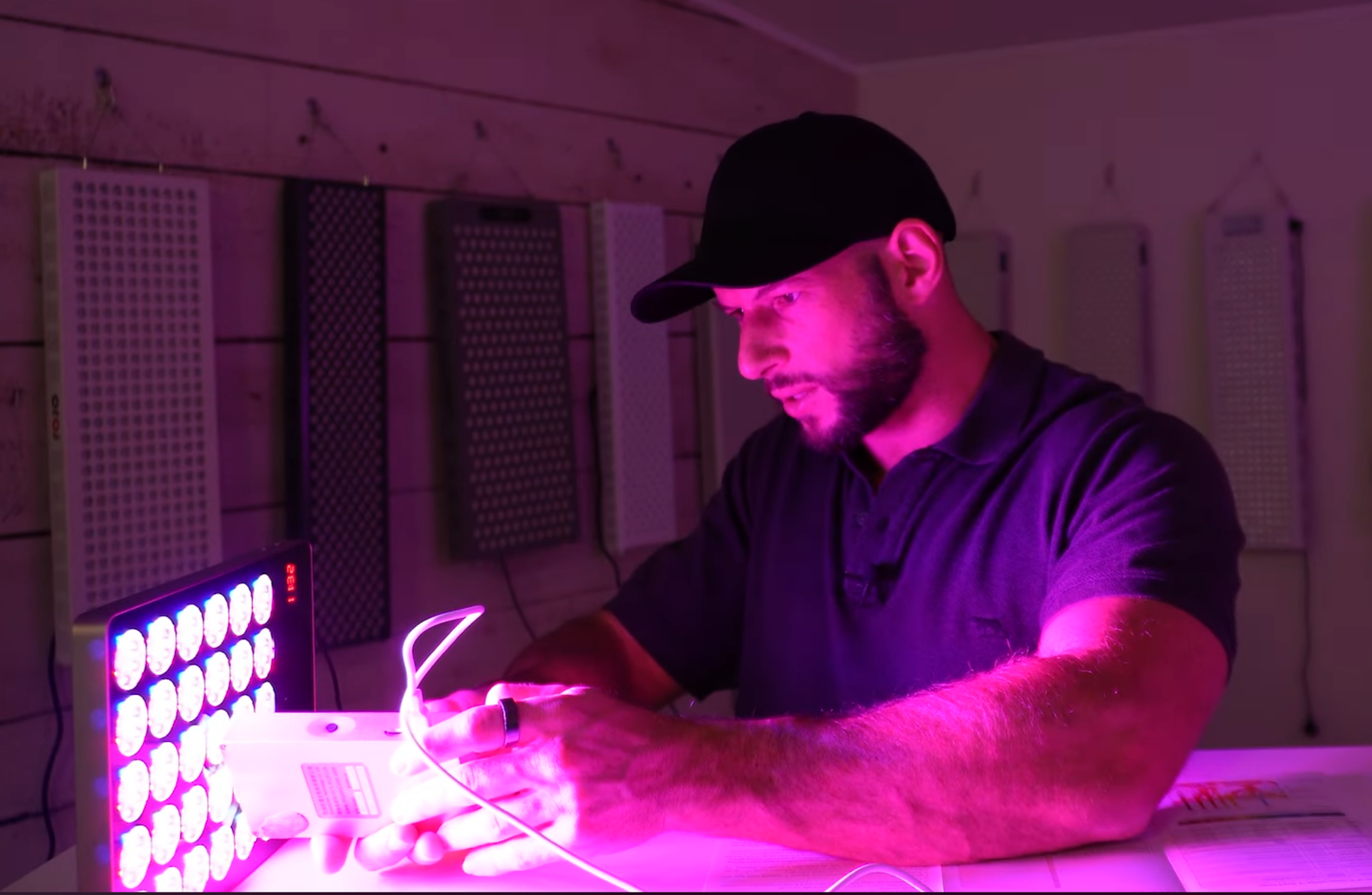
Price
The Jovs Alva retails for $379, but if you use my affiliate link and discount code ALEX, you get a 10% discount. There is free international shipping, and the Alvas comes with a one-year warranty and a 90-day satisfaction guarantee.
Breaking It Down: Does This Device Work?
When it comes to red light therapy, the key question is: does this device deliver the results it promises? Let's break it down.
Wavelengths: What’s Being Emitted?
Visually, it’s clear that this device emits multiple wavelengths through six different LED lenses, each putting out a different color. However, the real-world numbers don’t fully align with what’s marketed regarding wavelength accuracy and power output.
Pros:
- The device does emit the expected wavelengths: blue, red, amber, and near-infrared.
- Red wavelengths at 630nm and 660nm are present, crucial for skin rejuvenation.
Cons:
- The marketed wavelengths and the actual emitted wavelengths don’t match perfectly. For example, the amber light was supposed to peak at 590nm but closer to 600nm.
- Near-infrared is present, but the intensity isn’t as high as it should be.
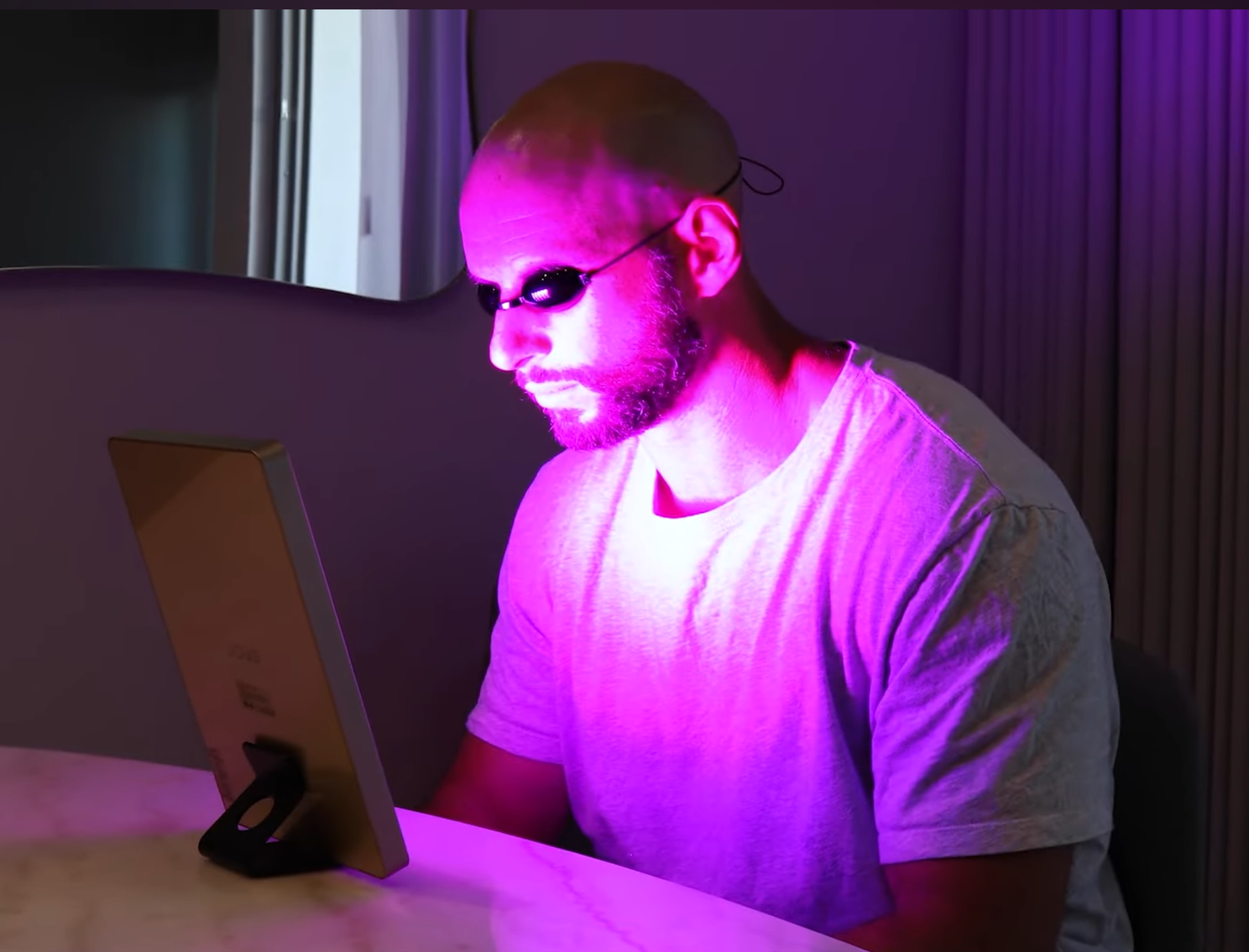
Is It Effective for Skin Beauty?
The real question is whether this device can deliver the skin beauty benefits it promises.
After my team and I had done extensive research into red light therapy and its effects on skin rejuvenation, we identified the key factors that make these devices effective.
Key Takeaways:
- Red Light (620-670nm): This range is the gold standard for skin rejuvenation. Fortunately, this device covers this range with 630 and 660nm LEDs.
- Amber Light (590nm): This light benefits skin health, particularly fine lines and wrinkles. While the device doesn’t exactly hit 590 nm, it does emit around 600nm, which still offers some benefits.
- Near-Infrared: Although present, the intensity is lower than ideal for deeper skin penetration.
- Blue Light: This light is great for acne and other skin issues, and the device includes it. However, it can be turned off if not needed.
Intensity and Power: Does It Measure Up?
Research shows that the intensity of light therapy matters for its effectiveness. Typically, you want between 10 and 50 milliwatts, depending on your proximity to the device.
Pros:
- The device does deliver intensity within the effective range, particularly when used close to the skin.
- You can run sessions without blue light, which can be stimulating or potentially damaging if you don’t need it.
Cons:
- At 6 inches away, the intensity I measured was around 14 milliwatts, which is on the lower end of the spectrum. This is adequate for basic skin benefits but might not be powerful enough for deeper treatments like joint pain or muscle recovery.
My Thoughts:
This device offers solid skin rejuvenation benefits, especially with its red and amber wavelengths. However, the power and wavelength accuracy is not quite as advertised, which could impact its effectiveness, particularly for deeper treatments.
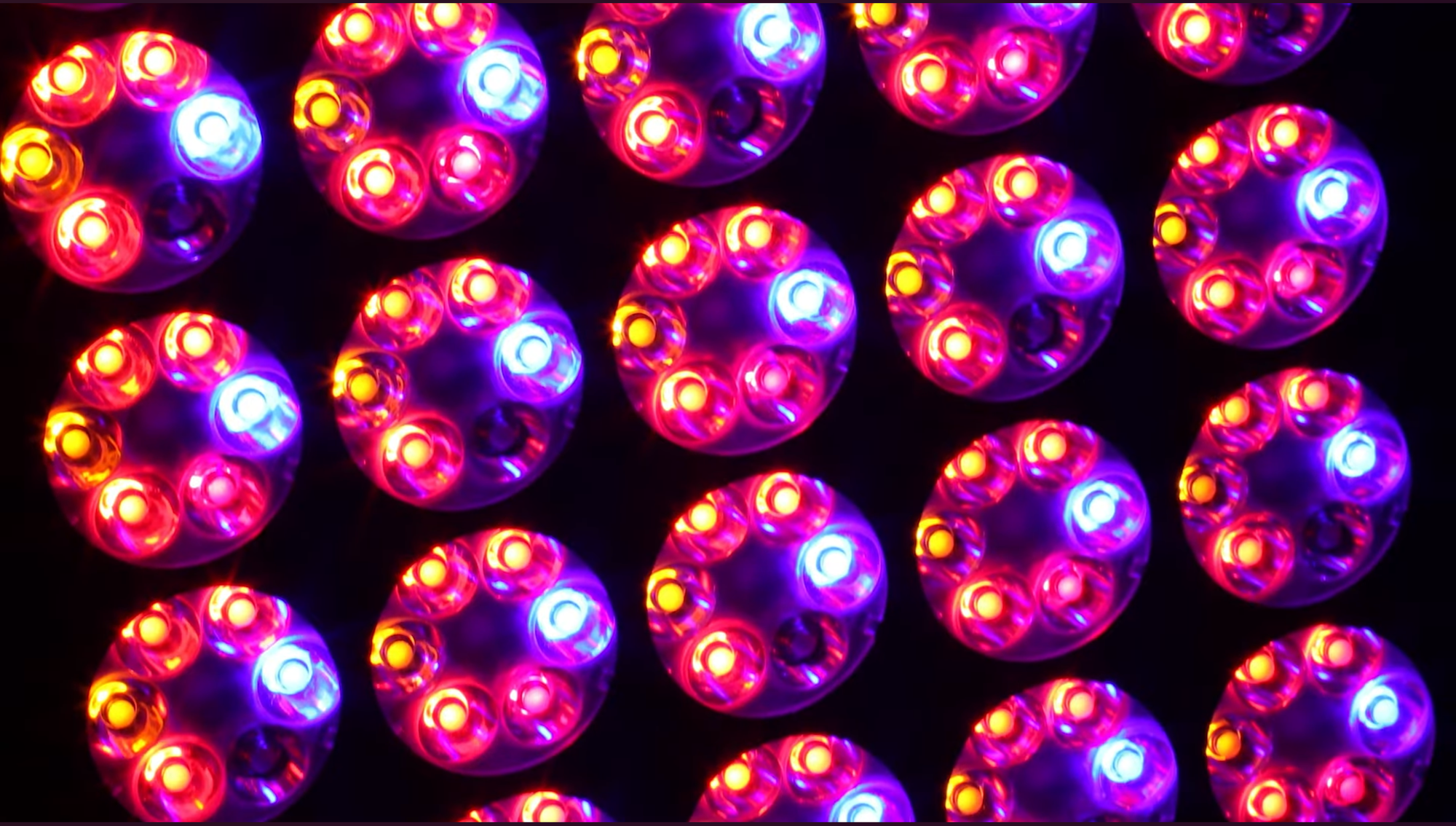
My Pros:
- Adequate Power for Beauty Treatments: Although the device doesn’t reach the advertised 130 milliwatts, its power levels are still suitable for skin beauty treatments, offering a safe and effective treatment without the risk of excessive energy exposure.
- Wide Spectrum of Wavelengths: The device features a range of wavelengths, from blue to amber, red, and near-infrared. This broad spectrum benefits various skin health concerns, including acne, collagen production, and skin rejuvenation. Including multiple wavelengths makes this device versatile and comprehensive for beauty-focused treatments.
- Portability and Convenience: The device is lightweight, wireless, and portable, allowing for flexible use without being tethered to a power outlet. You can move it around and prop it up on different surfaces to achieve optimal coverage, making it highly convenient for at-home use.
- Included Stand: The device comes with a basic metal stand that, while simple, gets the job done. Although it’s not the most advanced stand, it does provide a stable base for treatments. This adds convenience, even if it’s not the most feature-rich option.
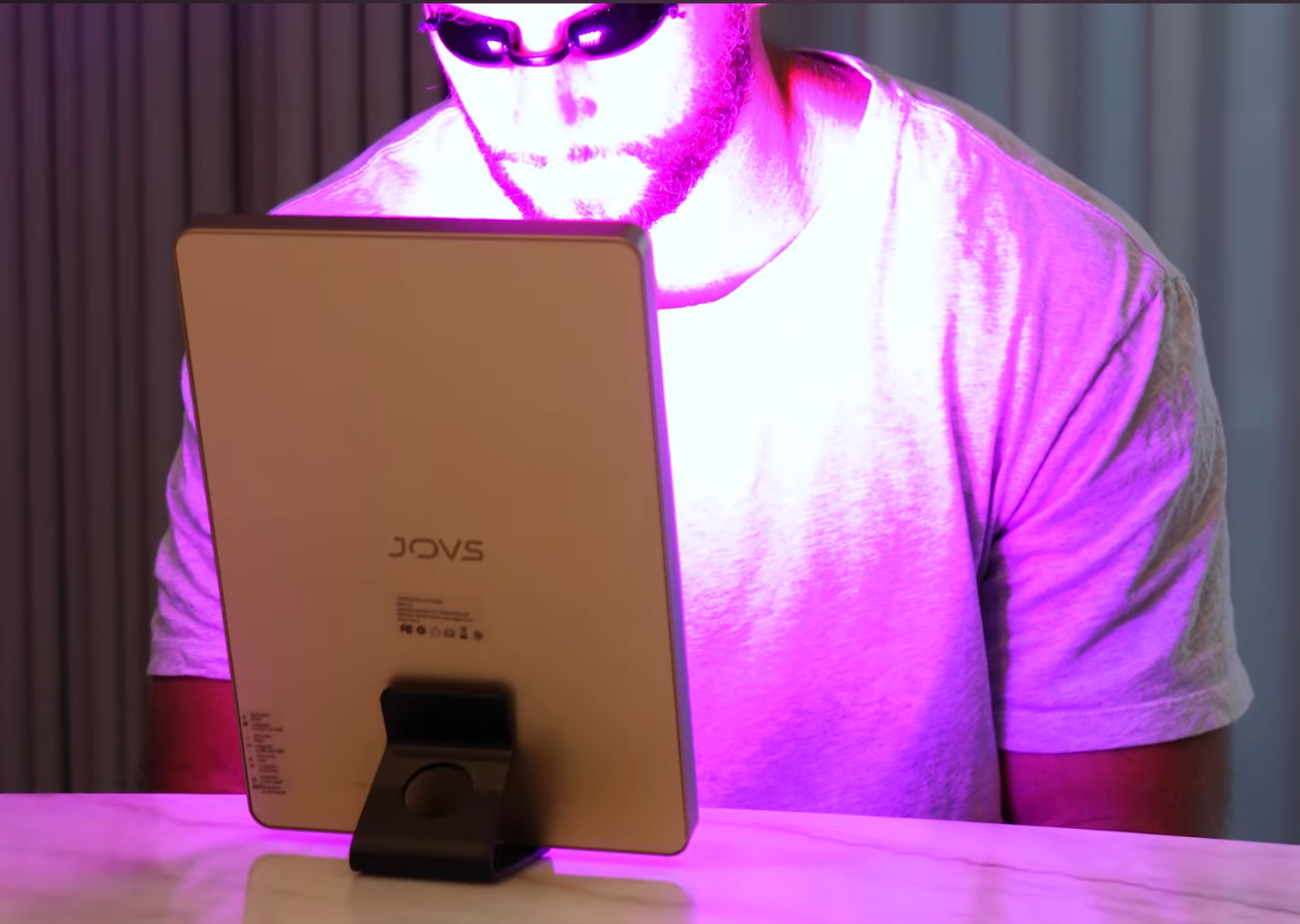
- Silent Operation: Unlike many red light therapy panels with noisy fans, this device operates silently, making it a more pleasant experience, especially for longer sessions.
- Multiple Mode Options: The device offers various modes, including wavelength combinations and pulsing settings. While some may find these options gimmicky, they provide flexibility, allowing users to customize their treatment to their specific needs.
- Warranty and Return Policy: The device is backed by a one-year warranty and a 90-day return period, offering buyers peace of mind. This shows the company’s confidence in its product and provides a safety net for concerned users.
My Cons:
- Significant Discrepancy in Advertised Power: The device’s advertised power output of 130 milliwatts is far from what it delivers, which can be misleading for consumers expecting high-intensity therapy. The actual power is much lower, which may not meet the expectations set by the marketing claims.
- Basic and Limited Stand: While the included metal stand is functional, it’s pretty basic. It lacks advanced features like a movable pivoting arm, which would have added versatility to the device’s use. This could be a letdown for those accustomed to more flexible stands like those with higher-end panels.
- Frustrating User Interface: Operating the device can be confusing and frustrating due to its poorly designed controls. The buttons are not intuitive, with two buttons that function as four. This makes it challenging to navigate the settings, especially for first-time users. The lack of clear labeling and the complex button design could be a significant drawback.
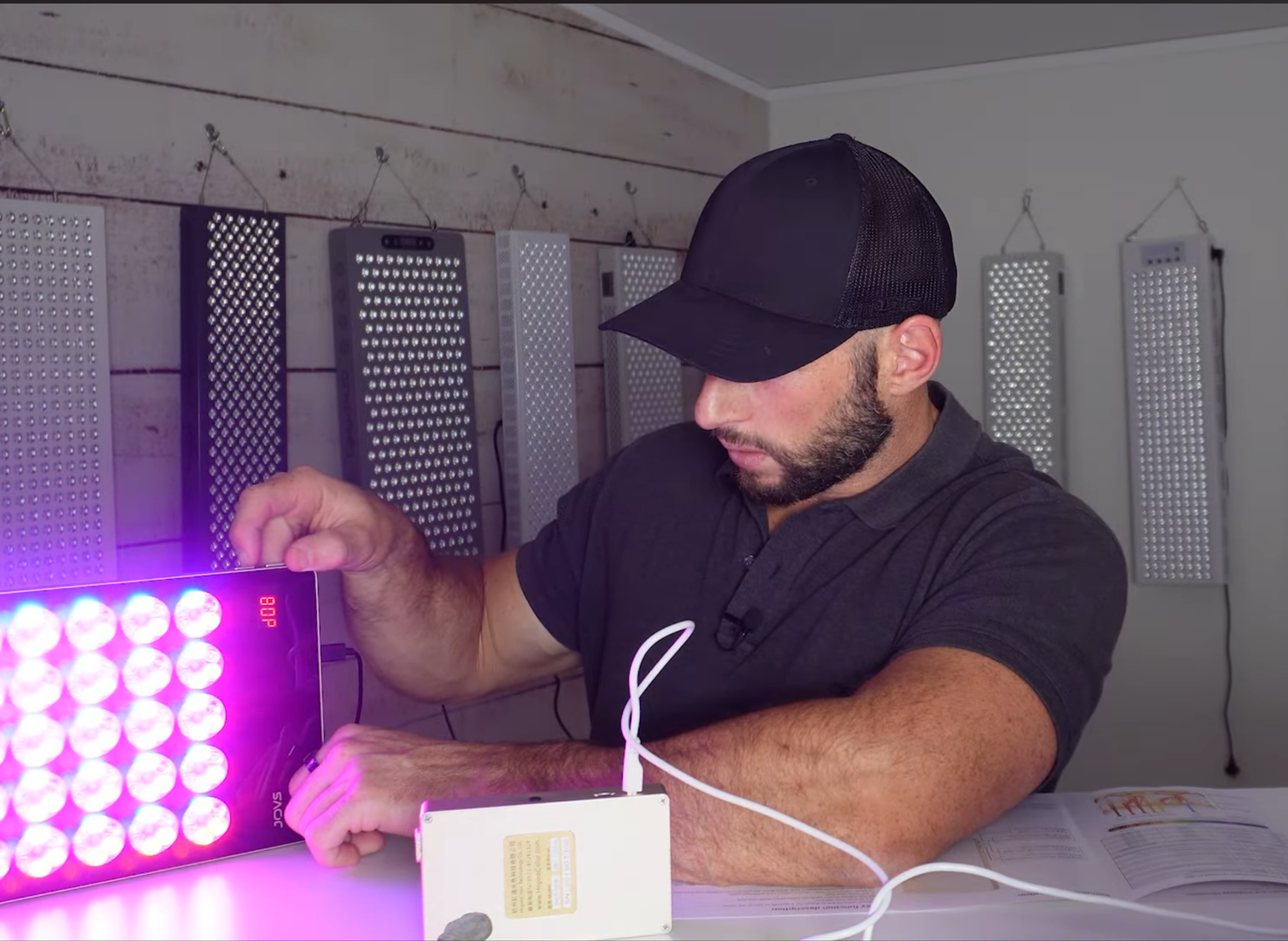
- Lack of a Basic App: A simple app that allows users to control the device settings would have made the operation much more straightforward. The current setup, which relies solely on the buttons, feels outdated and cumbersome. An app could have streamlined the process, offering an easier way to select wavelengths, adjust the timer, and toggle pulsing modes.
- Unnecessary Gimmicks in Modes: While the device offers multiple modes, not all may be necessary or beneficial. Some users might find these additional options more confusing than helpful, especially if they’re unsure which settings are optimal for their needs.
Alternatives to Consider
Below you'll find a few alternatives to consider:
Masks: The Closest Competitor?
First up, we've got the Jovs 4D mask. It's similar because it offers multiple wavelengths but is a different form factor. You wear it on your face, getting more targeted treatment but less overall coverage. It's also about twice the price of the Alva, so keep that in mind.
I've played with masks before, and they're not my favorite. They can feel claustrophobic, and you're pretty limited in what you can do while wearing one. Some people love them, it's worth considering if you're all about face-focused treatment.
Full-Sized Panels: More Power, Less Portability
Consider a full-sized panel if you want to go bigger (and pricier). The BioMax 300 is one option—it has seven wavelengths, including blue light but no amber. It's a beast compared to the Alva, both in size and power. You're looking at about $700 with a stand, but you're getting something that can treat your whole body and even help with joint issues.
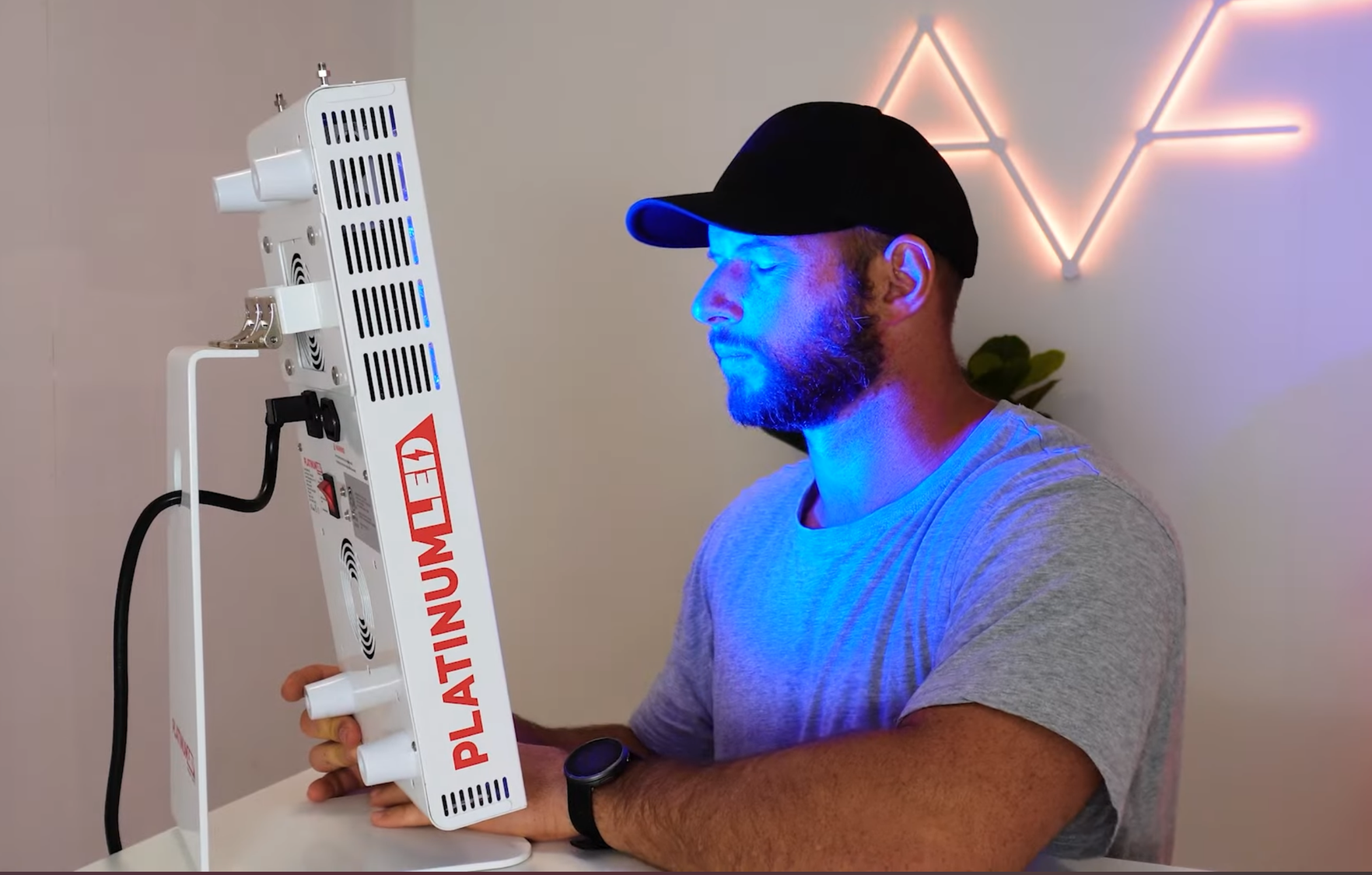
Another option is the Mito Red Light MitoPRO series. These have amber light and are cheaper than the PlatinumLED products. But here's the thing - these panels must be plugged into the wall. You're trading portability for power.
Handheld Devices: Portable But Limited
Some handheld devices might be closer to Alva's—the Jovs Alva is in a unique spot. No direct competitor offers this combination of portability, multiple wavelengths, and a price range.
I've reviewed a few of these before, and I'll link those for you at the end of this article. They're portable, sure, but they're usually pretty limited in terms of coverage area and wavelength options.
The Unique Position of the Jovs Alva
Here's the thing—the Jovs Alva is in a pretty unique spot right now. No direct competitor offers this combination of portability, multiple wavelengths, and a focus on skin benefits.
The closest alternatives are probably masks, but if you're like me and not a fan of wearing a light therapy device on your face, the Alva becomes pretty attractive.
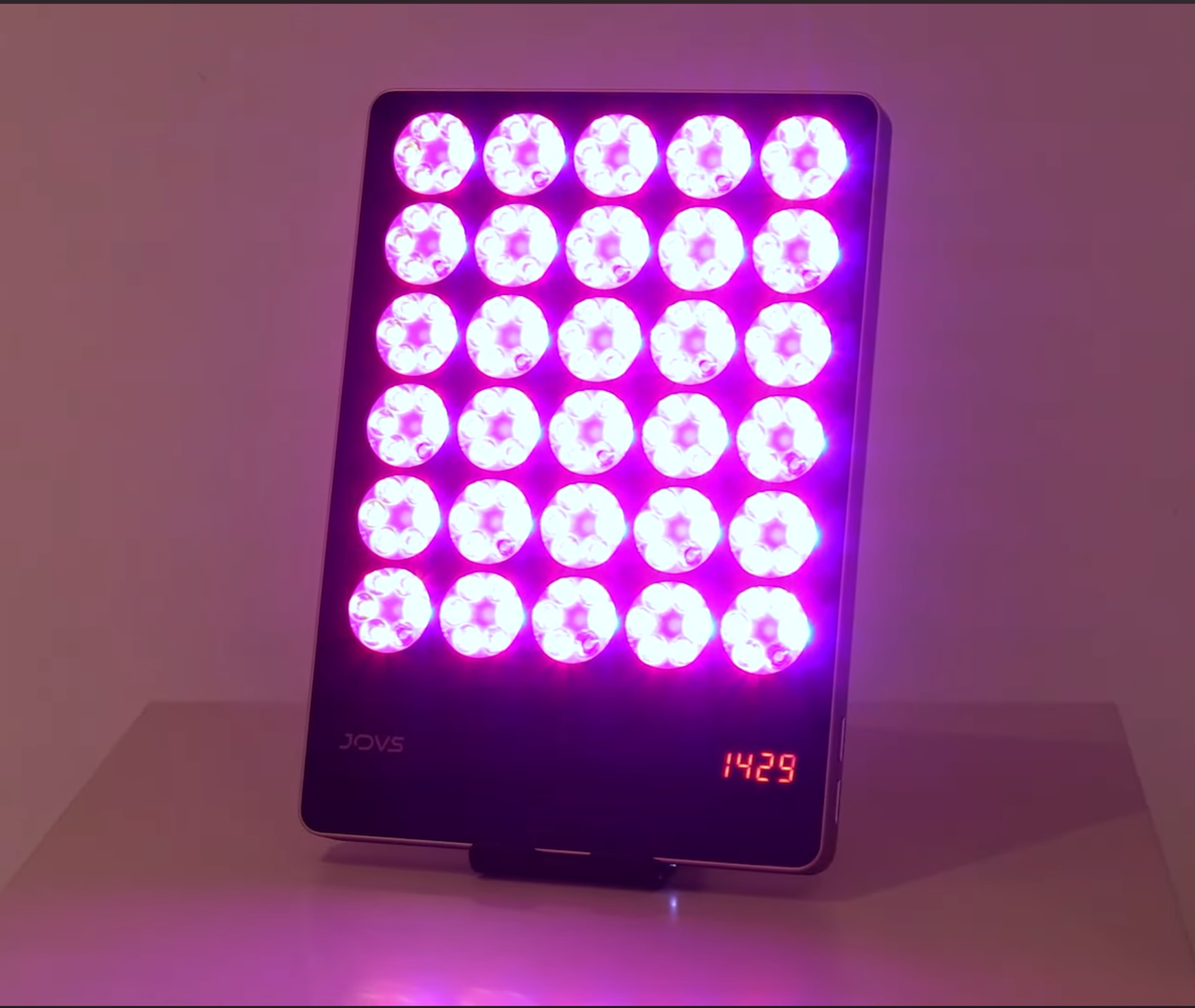
Final Thoughts
I know I've pointed out some issues with the Alva, but I've got to admit - I'm a fan. It's unique, ticks many boxes, and comes at a reasonable price point with free shipping. That's hard to beat.
Would I love to see a Gen 2 version with a better control panel, more accurate wavelengths, and maybe more stand options? Absolutely. But even as it is, it's a solid option in the portable light therapy market.
Who knows, maybe we'll see a full-body panel version of this. Now, that would be interesting!
Bottom line: If you're looking for a portable, versatile light therapy device primarily for skin benefits, the Jovs Alva is worth considering. Just go into it with realistic expectations, and you might be pleasantly surprised.
Items Mentioned:
✅ Get a Jovs 4d by clicking here: - discount code ALEX saves!
✅ Get a PlatinumLED BioMax - a unique discount code is generated after you click the link
✅ Get a Mito Red Light MitoPRO X - The discount will automatically apply at checkout if you use that link.
Found This Interesting? Look At These Articles:
- 660nm Wavelength Health Effects Cheatsheet
- Red Light Therapy For Skin: Beauty Benefits, Potential Complications, And More
- The 830nm Wavelength Health Effects Cheatsheet
- Red Light Therapy: What’s The Ideal Distance from Skin?
- Red Light Therapy Dosing Chart: The Raw Data From Hundreds Of Studies
Consider These YouTube Videos As Well:
- Targeted Red Light Treatment = Full-Body Benefits?
- Lightpath LED Torch Review: Innovative Spot-Treatment?!
- LED Mask Vs Red Light Therapy Panel: Which Is BEST?
- How To Choose A Red Light Therapy Device: COMPLETE Guide
- LED Mask Benefits: SUPERB For Skin, Beauty & Anti-Aging?
This blog post was written by Alex Fergus. Alex is a ISSN Sports Nutrition Specialist, Fitness Professional and certified Superhuman Coach who continues to expand his knowledge base and help people across the world with their health and wellness. Alex is recognized as the National Record Holder in Powerlifting and Indoor Rowing and has earned the title of the Australian National Natural Bodybuilding Champion. Having worked as a health coach and personal trainer for over a decade, Alex now researches all things health and wellness and shares his findings on this blog.

